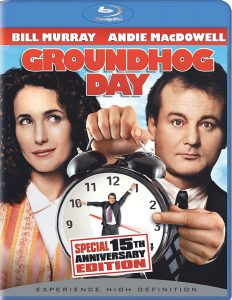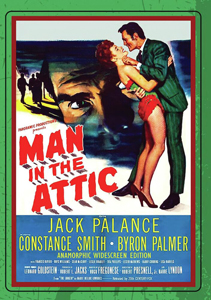Watch Alfred Hitchcock’s “The Lodger: A Story of the London Fog” (1927) to get the suspense of Marie Belloc Lowndes 1913 novel “The Lodger.” If that’s a movie about “who” – asking whether the titular renter is the local serial killer or not – then a later adaptation, “Man in the Attic” (1953), is a story of the “why.” This is a version to watch if you’re asking “Why would someone commit serial murders?”
Hitchcock’s version does more with less – the clues and revelations are thinner, and indeed, the movie has no sound (other than a later-added score), as it is from the silent era. Director Hugo Fregonese’s “Man in the Attic,” though not as artful, explores damaged psychology via dialog. And again it makes smart casting decisions.
As a lodger named Slade, Jack Palance is your classic powerfully built, square jawed man. Like Christopher Reeve would later do when playing Clark Kent, Slade is soft-spoken with an air of vulnerability because he doesn’t smoothly fit into this world. The niece of the landlords, sexy vaudeville dancer Lily (Constance Smith), takes a liking to Slade.

“Man in the Attic” (1953)
Director: Hugo Fregonese
Writers: Robert Presnell Jr., Barré Lyndon (screenplay), Marie Belloc Lowndes (novel)
Stars: Jack Palance, Constance Smith, Byron Palmer
Like Lowndes’ novel and unlike Hitchcock’s version, “Man in the Attic” is openly a Jack the Ripper story, set in 1888 in London. Interestingly, the theme of psychology as a medical branch emerged into mainstream cinema with Hitchcock’s “Spellbound” less than a decade before this film. “Man in the Attic” is set in 1888, so it can’t be a direct, analytical psych examination.
But Lily is an armchair psychologist of sorts, and Slade an armchair patient. She gets this shy man to talk about his mother – whom he loved for her beauty and hated for her behavior. There’s maybe a bit of Norman Bates in Slade, come to think of it.
The fog clears … not necessarily for the better
Film historians consider 1960 to mark the roots of psychological horror (and perhaps the slasher subgenre), due to “Psycho” and “Peeping Tom.” When considering that historical timeline, it’s like “Man in the Attic” isn’t quite ready to be that type of film.
Writers Robert Presnell Jr. and Barré Lyndon create space for something stylishly dark, notably in Inspector Warwick’s (Byron Palmer) tour for Slade and Lily of a bizarre private museum within the police precinct. It includes the nooses used to hang serial killers, plus “death masks” (plaster casts) of the killers’ faces, mounted on the wall like hunting trophies. If there’s a difference between what criminals and police do, and the macabre ways they view the world, maybe it’s only in the sequence of events: The criminals act first.

Also including some light humor via witty dialog, “Man in the Attic’s” screenplay has these off-kilter qualities. But Fregonese directs in a straightforward and competent manner. Had this been a straight mystery, it might’ve clicked better, but I never was clear if this is even supposed to be a mystery, since it has only one suspect. Single-suspect “mysteries” must embrace the weird in order to make an impact, with a prime example being the slasher classic “Sleepaway Camp.”
By being slick and classy, the black-and-white “Man in the Attic” is, well, rather black and white when all is said and done. While it’s closer to Lowndes’ novel than Hitchcock’s film – namely because it’s unambiguously about Jack the Ripper – it plays like a middle-of-the-road effort among the six adaptations.
Indeed, that’s what IMDb voters have concluded, as “Man in the Attic” rates a 6.1, compared to 7.3 for Hitchcock’s “The Lodger.” An “Armchair Mystery Theater” TV adaptation in 1956 ranks the highest at 8.1, and a 1944 film rates a 7.1. But “Man in the Attic” does outpace 1932’s version, called “The Phantom Fiend” (5.6), and a 2009 horror version (5.7).
RFMC’s Alfred Hitchcock series reviews works by the Master of Suspense, plus remakes and source material. Click here to visit our Hitchcock Zone.

